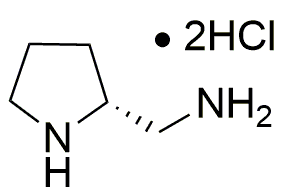(R)-2-(Aminomethylpyrrolidine dihydrochloride is widely utilized in research focused on
- Pharmaceutical Development: This compound serves as a key intermediate in the synthesis of various pharmaceuticals, particularly in the development of drugs targeting neurological disorders.
- Neuroscience Research: Its unique structure allows researchers to explore its effects on neurotransmitter systems, making it valuable in studies related to mood disorders and cognitive function.
- Biochemical Assays: The compound is often used in biochemical assays to evaluate enzyme activity or receptor binding, providing insights into cellular mechanisms.
- Drug Formulation: Due to its properties, it can enhance the solubility and bioavailability of certain drugs, improving their effectiveness in therapeutic applications.
- Material Science: It is also explored in the development of new materials, particularly in creating polymers with specific functional properties for industrial applications.
General Information
Properties
Safety and Regulations
Applications
(R)-2-(Aminomethylpyrrolidine dihydrochloride is widely utilized in research focused on
- Pharmaceutical Development: This compound serves as a key intermediate in the synthesis of various pharmaceuticals, particularly in the development of drugs targeting neurological disorders.
- Neuroscience Research: Its unique structure allows researchers to explore its effects on neurotransmitter systems, making it valuable in studies related to mood disorders and cognitive function.
- Biochemical Assays: The compound is often used in biochemical assays to evaluate enzyme activity or receptor binding, providing insights into cellular mechanisms.
- Drug Formulation: Due to its properties, it can enhance the solubility and bioavailability of certain drugs, improving their effectiveness in therapeutic applications.
- Material Science: It is also explored in the development of new materials, particularly in creating polymers with specific functional properties for industrial applications.
Documents
Safety Data Sheets (SDS)
The SDS provides comprehensive safety information on handling, storage, and disposal of the product.
Product Specification (PS)
The PS provides a comprehensive breakdown of the product’s properties, including chemical composition, physical state, purity, and storage requirements. It also details acceptable quality ranges and the product's intended applications.
Certificates of Analysis (COA)
Search for Certificates of Analysis (COA) by entering the products Lot Number. Lot and Batch Numbers can be found on a product’s label following the words ‘Lot’ or ‘Batch’.
*Catalog Number
*Lot Number
Certificates Of Origin (COO)
This COO confirms the country where the product was manufactured, and also details the materials and components used in it and whether it is derived from natural, synthetic, or other specific sources. This certificate may be required for customs, trade, and regulatory compliance.
*Catalog Number
*Lot Number
Safety Data Sheets (SDS)
The SDS provides comprehensive safety information on handling, storage, and disposal of the product.
DownloadProduct Specification (PS)
The PS provides a comprehensive breakdown of the product’s properties, including chemical composition, physical state, purity, and storage requirements. It also details acceptable quality ranges and the product's intended applications.
DownloadCertificates of Analysis (COA)
Search for Certificates of Analysis (COA) by entering the products Lot Number. Lot and Batch Numbers can be found on a product’s label following the words ‘Lot’ or ‘Batch’.
*Catalog Number
*Lot Number
Certificates Of Origin (COO)
This COO confirms the country where the product was manufactured, and also details the materials and components used in it and whether it is derived from natural, synthetic, or other specific sources. This certificate may be required for customs, trade, and regulatory compliance.


